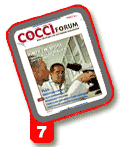COCCI FAQsSchering-Plough’s tech service team answers questions about managing coccidiosis in broilersQ. HOW PREVALENT ARE EIMERIA MAXIMA VARIANTS IN THE US, AND IS COCCIVAC-B CROSS-PROTECTIVE?
A. Based on a recent survey of 33
isolates of Eimeria maxima collected
from 11 states and 18 major poultry
integrators throughout the US, only
three of the isolates (less than 10%)
showed only partial protection by the
Coccivac strain of E. maxima. In other
words, the prevalence of E. maxima
among US poultry integrators that is
highly variant to the E. maxima in
Coccivac is very low and is not of
major significance at this time.
A. Autogenous vaccines are derived
from uncharacterized Eimeria field
species. These poorly defined species
are not subjected to the same rigorous
testing as the licensed, defined species
of Coccivac. To develop a safe, consistent
vaccine, it is imperative that the
basic species characteristics such as
pathogenicity, antigenicity and anticoccidial
drug sensitivity are well
defined. Using a poorly defined vaccine
highly increases the risk of rapidly
spreading unwanted contaminates from
a few selected farms to all company
farms, which could be an overnight disaster
and a very expensive problem to
control later; it also decreases the
chances of maximizing production performance
due to inconsistent product
manufacturing from serial to serial.
A. Yes. All research to date supports
our initial hypothesis that the vaccine
strains over 2 to 3 flocks are displacing
wild field strains. This is evident by the
Eimeria population shift toward more
sensitive strains as measured via anticoccidial
sensitivity testing (AST).
A. It is not a permanent change —
it’s a shift. The vaccine strains become
predominant in the absence of drug
pressure. With drug pressure and time,
the strains will shift back to those that
are drug tolerant/resistant.
A. It’s difficult to say specifically
how many, but the longer the removal
of pressure from the drugs, the greater
the chance of seeing a change in the
Eimeria population. We can say, however,
that there should be a minimum
of two cycles and that three cycles are
preferred.
A. Layout time will influence the
desiccation rate of Eimeria. Coccidia
will not be eliminated, but the longer
the layout period, the greater the
reduction in numbers.
A. Yes. Make sure the vaccines are
never frozen, which will kill or damage
sporulated oocysts and ruin their effectiveness.
A. Yes. Potency testing in live birds
is conducted on every serial (batch) of
Coccivac manufactured. Birds are vaccinated
with the serial being tested and
are then challenged with every species
of Eimeria contained in the vaccine to
make sure they develop immunity. If
they have developed immunity, they
do not develop coccidiosis. The validity
of each potency test is checked by
challenging unvaccinated birds.
A. Yes. When the Spraycox spray
cabinet is used, chicks can be vaccinated
in the hatchery because the sprayer
enables uniform distribution; 21 ml of
coarse spray is delivered for each box
of 100 chicks. Chicks “preen” to clean
and dry their feathers and ingest the
vaccine. Red dye mixed in with the
vaccine gets their attention and stimulates
preening.
A. It enables simultaneous administration
of Coccivac-B and Newcastle/
Bronchitis (ND/IB) vaccines, which in
turn provides producers with convenience
and reduced labor costs. The
nozzle for Coccivac delivers the coccidiosis
vaccine as droplets that are
ingested by preening. The nozzle for
ND/IB produces a flat, even spray
across the box.
A. You’ll get more uniform results if
the initial stocking density is 0.75 ft2 to
1.0 ft2 per bird. Higher stocking density
could result in excessive litter moisture
and a high litter oocyst density.
A. A minimum litter moisture content
of about 25% is needed to stimulate the
coccidial life cycle, but too much moisture
will lead to poor Coccivac results.
If the litter is too wet, coccidial cycling
may be heavy, causing too much reaction
in birds and even overgrowth of
the bacteria that causes necrotic enteritis.
Too much litter moisture also can
lead to transient immunosuppression
due to “cold stress” as well as high
ammonia, resulting in blindness and
poor flock uniformity.
A. One way to reduce litter moisture
is by properly maintaining nipple
drinkers, which reduce the amount of
water spilled into the litter. Consider
your ration formulation. Some rations
reduce the amount of excreted moisture.
Litter type and depth should
accommodate the amount of moisture
expected in the house. Ventilation also
can be adjusted to control litter moisture.
Bird density needs to be controlled
to avoid the moisture concentration. |




 © 2000 - 2021. Global Ag MediaNinguna parte de este sitio puede ser reproducida sin previa autorización.
© 2000 - 2021. Global Ag MediaNinguna parte de este sitio puede ser reproducida sin previa autorización.